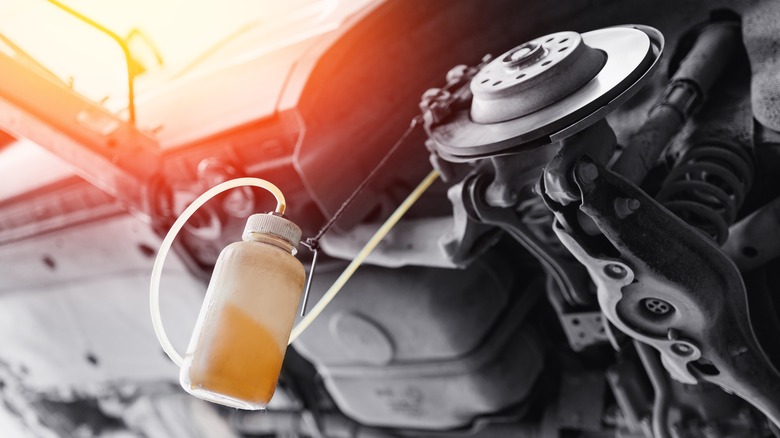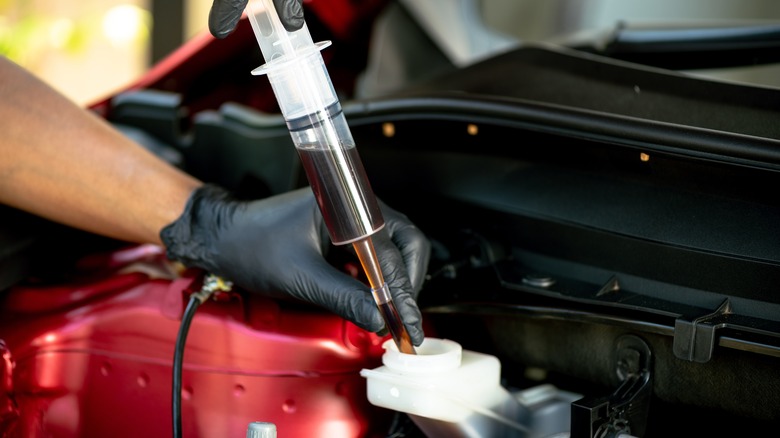
Bleeding your car's brakes sounds intimidating until you actually do it. If your brake pedal feels squishy, or you've just replaced brake pads or lines, bleeding the system can bring your stopping power back to full strength. Air in the brake lines compresses more easily than brake fluid under pressure, making braking less responsive, resulting in that discomforting squishy pedal feel. The solution is to push that air out of the system, and yes, you can do it solo.
Even if your car has automated braking, and probably all of them will in the near future, you'd want the brakes to work optimally in the first place for the system to be effective. So start by grabbing a few basic tools; usually a 10-millimeter wrench for the bleeder valve, a clear hose or tube, a catch bottle or pan, fresh brake fluid recommended by your car's manufacturer and a brake bleeder kit. And yeah, it sounds obvious, but you still need to jack up the car and pull the wheels out; no one's bleeding brakes through a set of alloys.
 Parilov/Shutterstock
Parilov/Shutterstock
Bleeding usually follows a specific order. For most vehicles, you'll want to start with the caliper farthest from the master cylinder, typically the right rear, then work your way to the nearest, ending at the left front. If in doubt, double-check your vehicle's owner's manual or service guide to be sure.
Alright, time to get messy. Pop the hood and fill that brake master cylinder to the "Max" line. Keep it there, if it runs dry, you'll be chasing air bubbles all day. Slip a clear hose over the bleeder screw, which usually lives on the brake caliper or wheel cylinder. Drop the other end into your catch bottle. Crack the bleeder open just a tad. Now pump the brake pedal slowly, hold it down, watch the mix of old fluid and air bubbles shoot through the hose. Close the valve before you lift the pedal, or you'll suck air right back in. Repeat this at each corner until the fluid runs clean and bubble-free.
And here's the most crucial step people always forget — top off the brake fluid reservoir after every wheel. Miss it, and you'll run the master cylinder dry and undo everything you just did. Careful not to get brake fluid on your car's paint to avoid any damage. Keep rags and brake cleaner handy, because spills happen, and always use nitrile gloves and safety glasses.
 Nor Gal/Shutterstock
Nor Gal/Shutterstock
No friends? No problem. Gravity bleeding has your back and doesn't need snacks or small talk. It takes longer, but it's easy and doesn't need extra hands. Just open the bleeder screw, hook up your hose and catch bottle, and let gravity do the work. Keep an eye on the fluid level and wait until you see a steady stream with no air bubbles.
There are also one-man brake bleeder kits, with a check valve that lets you pump the brake pedal without letting air back in. It doesn't require you to close the bleeder nipple between pumps. Vacuum bleeders make the process faster and can pull fluid through the system from the bleeder screw end. Reverse bleeding is also an easy method to push fresh brake fluid through the bleeder towards the brake fluid reservoir, so the air bubbles naturally travel upwards.
No matter which method you choose, always test your brake pedal afterward. It should feel firm and if not, go another round. Brakes aren't something you half-fix, so done right, this is one of the most satisfying and confidence-boosting DIY jobs you can do in your driveway.














